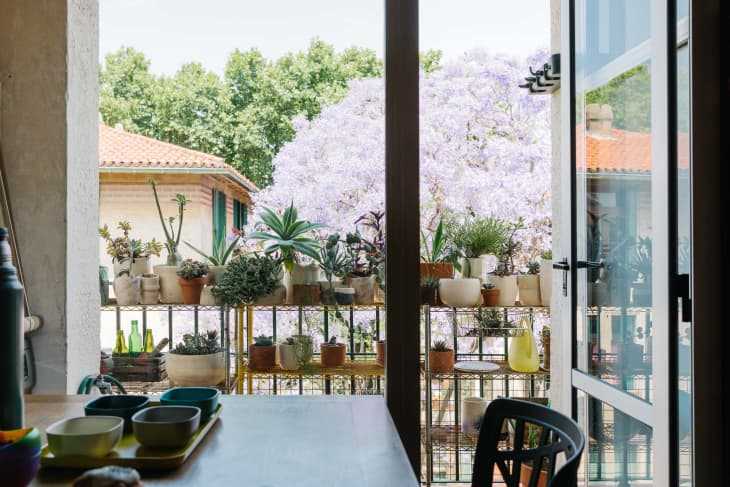I’ve never identified as a plant parent in the way that many people in the plant community do. (How many? #Plantparenthood has 1.1 million+ posts on Instagram alone.) I get it: People care for plants to keep them alive, and so the plants are their “children.” Even so, a parenting relationship has never been one that I’ve had with my plants. Maybe that makes me a bad plant parent. Maybe that’s why I’m starting over.
In March 2020, I had just moved around 30 plants into a new apartment, one that was already occupied by someone else. My plants awkwardly fit into corners and on tabletops, placed on a newly hung shelf in the living room, or relegated to the balcony to accommodate the plant-curious cat. They helped make someone else’s space feel a little more like my home.
As life started to feel increasingly isolated during the pandemic, I looked to my plants for signs of life. Budding leaves unraveled against all odds in their newly harsh environment. Despite the dying leaves below, nature was resilient. It made me feel like I could be, too.
At some point, I had to leave, so I left my plants in the care of the aforementioned someone else. It didn’t work out. I returned a few months later to a plant graveyard. Some brown skeletons lingered; others were just ghosts in emptied pots. I’m not sure which was worse: to see their crunchy dead forms, or to never know what they looked like after life had evaporated.
I was angry at first, then scorned, then sad. No one can really care for your plants like you, the person who nurtured them and was nurtured in return. I cried. I mourned. I got rid of the remains. Some goodbyes were tough — my Chinese Evergreen, my first-ever plant, survivor of multiple rounds of pests, who’d grown strong white roots and flowers in warmer months; the fiddle leaf fig I’d clipped from my brother’s abundant tree, my first attempt at propagation. Other goodbyes, I hate to say, were a relief. I had been grateful for all of my plants, but I didn’t connect with all of them in the same way.
Eventually, I left that apartment one more time, not exactly ready for my fresh start, but showing up nonetheless. Learning from my loss, I’m moving into this new phase with a more thoughtful approach, and am attempting to build a plant collection full of specimens that I actively delight in caring for, and that gives me what I’m looking for in return. Rebuilding has the benefit of learning from lived experiences, on a technical level, sure, but more importantly, on an emotional one. Here’s how I’m approaching my new plant collection with mindfulness:

Consider what you want to get out of your plant collection, and select plants accordingly.
I want to feel like an active part of my plants’ lives, so I prefer plants that require regular misting and occasional pruning. In return, I like to see frequent signs of life — things like active growth and perked-up leaves after watering. Low-maintenance slow-growers, like Dracaenas, may not have a place in my new collection, but vining Philodendrons do. In fact, I already have two: one Heartleaf and one Brasil. Another way to approach this is to gravitate toward productive plants, like fruit trees, or reliable, statuesque plants, like snake plants.
Check out your local nurseries and find one you vibe with.
Different nurseries will carry different plants; they’ll care for their plants differently, and they’ll provide you with information differently, including the growers where they originated as well as care recommendations. You may hit the jackpot and fall in love with the first nursery you visit, or you may, like me, check out three Home Depots and four nurseries before you find the place you trust. You may even end up exclusively shopping online. Feeling good about your collection starts with the buying process. Make it a pleasant one.
Incorporate plants that make you happy when you look at them, and then throw in some wildcards.
People always ask, “what’s your favorite plant?” My goal is to create a collection where I cannot pick. Some plants feel infused with meaning — an orchid, my grandpa’s favorite, and a Chinese Evergreen, received as a gift to honor the one I lost. Others I was drawn to for their look and I just thought it would be cool to get to know them, like a Philodendron Lickety Split, whose giant leaves unfurl like claws. Don’t get something just because it’s popular on Instagram or because Google says it’s easy to care for. Look at the plants available to you, touch their foliage, and see if you connect.
Make peace with pests.
It’s unrealistic to think that you can bring something created outside into your house and never see a pest of any kind. I try to use it as a bonding experience with my plants, and an opportunity to slow down. Take time to examine every leaf, carefully sponge-bathe it, trim off irredeemable bits, fluff the soil, and top it off with a thorough misting of Neem oil, or whatever treatment is appropriate. The care process can be just as therapeutic for you as it is for your plant.
Document your plants’ journeys.
Whether you choose to keep track with photos, spreadsheets, journal entries, or some other method, documenting your plants’ journeys will push you to notice things you might have missed otherwise — both potential problems, like unusually fast-drying soil or discoloration, and celebrations, like increased growth rate. The more you notice, the better you’ll know your plant and the better you can care for your plant. Observing details will place you in the moment, one tenet of mindfulness, and tracking them can help you realize your long-term goals. Once you know what you’re looking for, it’ll feel like your collection is growing itself.












